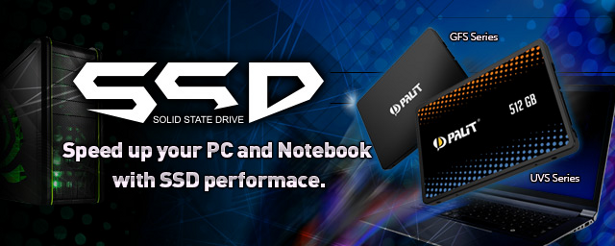Palit, traditionally known for its graphics cards, is dipping its toe into the SSD arena with two initial SATIII (6Gb/s) product series. The UF-S series utilize 3D TLC NAND, and the GF-S Series utilize 3D MLC NAND. The UF-S Series is being offered in capacities of 120GB, 256Gb, 480GB and 512GB. The GF-S Series is offered in capacities of 120GB, 128GB and 240GB.
 With SSDs quickly becoming the go-to choice for operating system drives for gamers, Palit’s GF-S Series of SSDs offer the quicker boot times and game level loads that gamers are seeking. The GF-S Series is being offered in capacities of 120GB, 128GB and 240GB. The GF-S Series feature 3D MLC NAND paired with a Phison S3111-S11 controller to achieve sequential read speeds of up to 540MB/s (120GB and 128GB), or 560MB/s (240GB). Sequential read speeds are stated as up to 450MB/s (120GB and 128GB), or 480MB/s (240GB).
With SSDs quickly becoming the go-to choice for operating system drives for gamers, Palit’s GF-S Series of SSDs offer the quicker boot times and game level loads that gamers are seeking. The GF-S Series is being offered in capacities of 120GB, 128GB and 240GB. The GF-S Series feature 3D MLC NAND paired with a Phison S3111-S11 controller to achieve sequential read speeds of up to 540MB/s (120GB and 128GB), or 560MB/s (240GB). Sequential read speeds are stated as up to 450MB/s (120GB and 128GB), or 480MB/s (240GB).
 Palit is also offering the UV-S Series of SSDs that utilize 3D TLC NAND paired with the same Phison S3111-S11 controller, which are able to attain sequential read speeds of up to 560MB/s (120GB and 256GB), or 525MB/s (480GB and 512GB). Sequential write speeds are stated as up to 375MB/s (120GB), 470MB/s (256GB), and 465MB/s (480GB and 512GB). While not stated, the UV-S Series appears to be geared more toward mainstream desktop/laptop/notebook usage than the GF-S Series.
Palit is also offering the UV-S Series of SSDs that utilize 3D TLC NAND paired with the same Phison S3111-S11 controller, which are able to attain sequential read speeds of up to 560MB/s (120GB and 256GB), or 525MB/s (480GB and 512GB). Sequential write speeds are stated as up to 375MB/s (120GB), 470MB/s (256GB), and 465MB/s (480GB and 512GB). While not stated, the UV-S Series appears to be geared more toward mainstream desktop/laptop/notebook usage than the GF-S Series.
 Both the GF-S Series and UV-S Series are built on the standard 2.5” x 7mm form factor, and operate via the standard SATA III (6Gb/s) interface. Both series offer low power consumption, LDPC ECC error correction code, static and dynamic wear leveling, and support the TRIM command where operating system compatible. All models are backed by a three-year limited warranty.
Both the GF-S Series and UV-S Series are built on the standard 2.5” x 7mm form factor, and operate via the standard SATA III (6Gb/s) interface. Both series offer low power consumption, LDPC ECC error correction code, static and dynamic wear leveling, and support the TRIM command where operating system compatible. All models are backed by a three-year limited warranty.
 Pricing and availability have not yet been announced. It will be interesting to see how these drives stack up against competing drives once reviewers have them in their hands to analyze and report on. For more information, you can view the Palit GF-S SSD product page here; and the UV-S SSD product page here.
Pricing and availability have not yet been announced. It will be interesting to see how these drives stack up against competing drives once reviewers have them in their hands to analyze and report on. For more information, you can view the Palit GF-S SSD product page here; and the UV-S SSD product page here.
 The SSD Review The Worlds Dedicated SSD Education and Review Resource |
The SSD Review The Worlds Dedicated SSD Education and Review Resource | 
Prototypes of this controller showed promising results, so i’m hoping coupled with 3d tlc we’ll get a capable budget performer